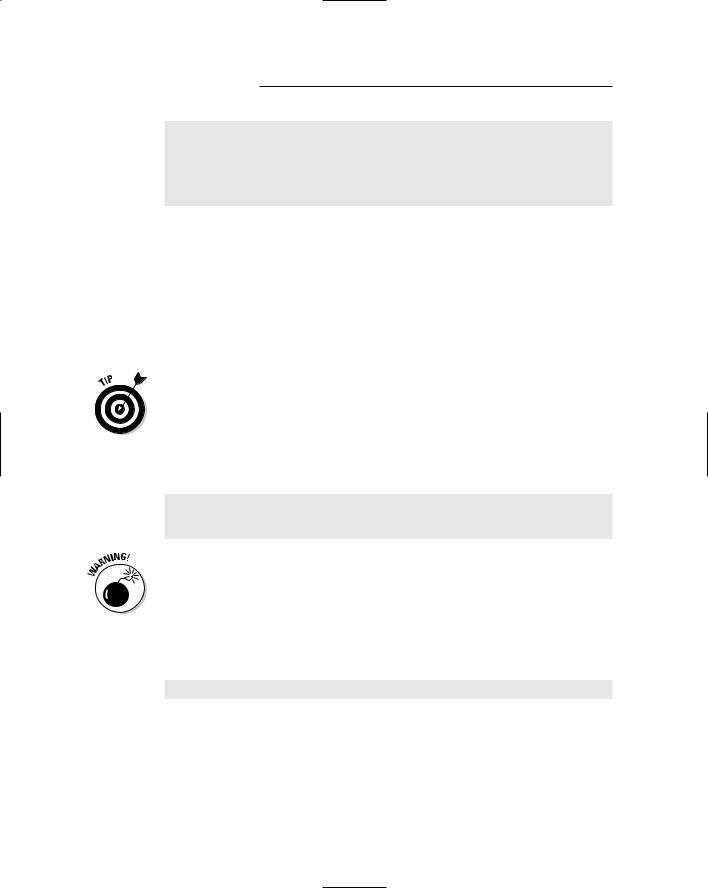
- •Table of Contents
- •Introduction
- •What Is C++?
- •Conventions Used in This Book
- •How This Book Is Organized
- •Part I: Introduction to C++ Programming
- •Part III: Introduction to Classes
- •Part IV: Inheritance
- •Part V: Optional Features
- •Part VI: The Part of Tens
- •Icons Used in This Book
- •Where to Go from Here
- •Grasping C++ Concepts
- •How do I program?
- •Installing Dev-C++
- •Setting the options
- •Creating Your First C++ Program
- •Entering the C++ code
- •Building your program
- •Executing Your Program
- •Dev-C++ is not Windows
- •Dev-C++ help
- •Reviewing the Annotated Program
- •Examining the framework for all C++ programs
- •Clarifying source code with comments
- •Basing programs on C++ statements
- •Writing declarations
- •Generating output
- •Calculating Expressions
- •Storing the results of expression
- •Declaring Variables
- •Declaring Different Types of Variables
- •Reviewing the limitations of integers in C++
- •Solving the truncation problem
- •Looking at the limits of floating-point numbers
- •Declaring Variable Types
- •Types of constants
- •Special characters
- •Are These Calculations Really Logical?
- •Mixed Mode Expressions
- •Performing Simple Binary Arithmetic
- •Decomposing Expressions
- •Determining the Order of Operations
- •Performing Unary Operations
- •Using Assignment Operators
- •Why Mess with Logical Operations?
- •Using the Simple Logical Operators
- •Storing logical values
- •Using logical int variables
- •Be careful performing logical operations on floating-point variables
- •Expressing Binary Numbers
- •The decimal number system
- •Other number systems
- •The binary number system
- •Performing Bitwise Logical Operations
- •The single bit operators
- •Using the bitwise operators
- •A simple test
- •Do something logical with logical calculations
- •Controlling Program Flow with the Branch Commands
- •Executing Loops in a Program
- •Looping while a condition is true
- •Using the for loop
- •Avoiding the dreaded infinite loop
- •Applying special loop controls
- •Nesting Control Commands
- •Switching to a Different Subject?
- •Writing and Using a Function
- •Divide and conquer
- •Understanding the Details of Functions
- •Understanding simple functions
- •Understanding functions with arguments
- •Overloading Function Names
- •Defining Function Prototypes
- •Variable Storage Types
- •Including Include Files
- •Considering the Need for Arrays
- •Using an array
- •Initializing an array
- •Accessing too far into an array
- •Using arrays
- •Defining and using arrays of arrays
- •Using Arrays of Characters
- •Creating an array of characters
- •Creating a string of characters
- •Manipulating Strings with Character
- •String-ing Along Variables
- •Variable Size
- •Address Operators
- •Using Pointer Variables
- •Comparing pointers and houses
- •Using different types of pointers
- •Passing Pointers to Functions
- •Passing by value
- •Passing pointer values
- •Passing by reference
- •Limiting scope
- •Examining the scope problem
- •Providing a solution using the heap
- •Defining Operations on Pointer Variables
- •Re-examining arrays in light of pointer variables
- •Applying operators to the address of an array
- •Expanding pointer operations to a string
- •Justifying pointer-based string manipulation
- •Applying operators to pointer types other than char
- •Contrasting a pointer with an array
- •Declaring and Using Arrays of Pointers
- •Utilizing arrays of character strings
- •Identifying Types of Errors
- •Choosing the WRITE Technique for the Problem
- •Catching bug #1
- •Catching bug #2
- •Calling for the Debugger
- •Defining the debugger
- •Finding commonalities among us
- •Running a test program
- •Single-stepping through a program
- •Abstracting Microwave Ovens
- •Preparing functional nachos
- •Preparing object-oriented nachos
- •Classifying Microwave Ovens
- •Why Classify?
- •Introducing the Class
- •The Format of a Class
- •Accessing the Members of a Class
- •Activating Our Objects
- •Simulating real-world objects
- •Why bother with member functions?
- •Adding a Member Function
- •Creating a member function
- •Naming class members
- •Calling a Member Function
- •Accessing a member function
- •Accessing other members from a member function
- •Defining a Member Function in the Class
- •Keeping a Member Function After Class
- •Overloading Member Functions
- •Defining Arrays of and Pointers to Simple Things
- •Declaring Arrays of Objects
- •Declaring Pointers to Objects
- •Dereferencing an object pointer
- •Pointing toward arrow pointers
- •Passing Objects to Functions
- •Calling a function with an object value
- •Calling a function with an object pointer
- •Calling a function by using the reference operator
- •Returning to the Heap
- •Comparing Pointers to References
- •Linking Up with Linked Lists
- •Performing other operations on a linked list
- •Hooking up with a LinkedListData program
- •A Ray of Hope: A List of Containers Linked to the C++ Library
- •Protecting Members
- •Why you need protected members
- •Discovering how protected members work
- •Protecting the internal state of the class
- •Using a class with a limited interface
- •Creating Objects
- •Using Constructors
- •Why you need constructors
- •Making constructors work
- •Dissecting a Destructor
- •Why you need the destructor
- •Working with destructors
- •Outfitting Constructors with Arguments
- •Justifying constructors
- •Using a constructor
- •Defaulting Default Constructors
- •Constructing Class Members
- •Constructing a complex data member
- •Constructing a constant data member
- •Constructing the Order of Construction
- •Local objects construct in order
- •Static objects construct only once
- •Global objects construct in no particular order
- •Members construct in the order in which they are declared
- •Destructors destruct in the reverse order of the constructors
- •Copying an Object
- •Why you need the copy constructor
- •Using the copy constructor
- •The Automatic Copy Constructor
- •Creating Shallow Copies versus Deep Copies
- •Avoiding temporaries, permanently
- •Defining a Static Member
- •Why you need static members
- •Using static members
- •Referencing static data members
- •Uses for static data members
- •Declaring Static Member Functions
- •What Is This About, Anyway?
- •Do I Need My Inheritance?
- •How Does a Class Inherit?
- •Using a subclass
- •Constructing a subclass
- •Destructing a subclass
- •Having a HAS_A Relationship
- •Why You Need Polymorphism
- •How Polymorphism Works
- •When Is a Virtual Function Not?
- •Considering Virtual Considerations
- •Factoring
- •Implementing Abstract Classes
- •Describing the abstract class concept
- •Making an honest class out of an abstract class
- •Passing abstract classes
- •Factoring C++ Source Code
- •Defining a namespace
- •Implementing Student
- •Implementing an application
- •Project file
- •Creating a project file under Dev-C++
- •Comparing Operators with Functions
- •Inserting a New Operator
- •Overloading the Assignment Operator
- •Protecting the Escape Hatch
- •How Stream I/O Works
- •The fstream Subclasses
- •Reading Directly from a Stream
- •Using the strstream Subclasses
- •Manipulating Manipulators
- •Justifying a New Error Mechanism?
- •Examining the Exception Mechanism
- •What Kinds of Things Can I Throw?
- •Adding Virtual Inheritance
- •Voicing a Contrary Opinion
- •Generalizing a Function into a Template
- •Template Classes
- •Do I Really Need Template Classes?
- •Tips for Using Templates
- •The string Container
- •The list Containers
- •Iterators
- •Using Maps
- •Enabling All Warnings and Error Messages
- •Insisting on Clean Compiles
- •Limiting the Visibility
- •Avoid Overloading Operators
- •Heap Handling
- •Using Exceptions to Handle Errors
- •Avoiding Multiple Inheritance
- •Customize Editor Settings to Your Taste
- •Highlight Matching Braces/Parentheses
- •Enable Exception Handling
- •Include Debugging Information (Sometimes)
- •Create a Project File
- •Customize the Help Menu
- •Reset Breakpoints after Editing the File
- •Avoid Illegal Filenames
- •Include #include Files in Your Project
- •Executing the Profiler
- •System Requirements
- •Using the CD with Microsoft Windows
- •Using the CD with Linux
- •Development tools
- •Program source code
- •Index

Chapter 27: Tempting C++ Templates 353
This approach works. Now C++ selects the best match, maximum(int, int), for a reference such as maximum(1, 2). However, creating the same function for each type of variable is a gross waste of time.
The source code for all the maximum(T, T) functions follows the same pat tern, where T is one of the numeric types. It would be so convenient if you could write the function once and let C++ supply the type T as needed when the function is used. In fact, C++ lets you write the maximum() function in exactly this way and provides an actual type for T as needed.
Generalizing a Function into a Template
A template function enables you to write what looks like a function but that uses one or more type holders that C++ converts into a true type at compile time.
The following MaxTemple program defines a template for a generic maximum() function:
// MaxTemplate - create a template max() function
// that returns the greater of two types #include <cstdio>
#include <cstdlib> #include <iostream>
using namespace std;
// simplistic exception class for this example only template <class T>
T maximum(T t1, T t2)
{
if (t1 > t2)
{
return t1;
}
return t2;
};
int main(int argc, char* pArgs[])
{
//find the maximum of two int’s cout << “The maximum of 1 and 2 is “
<<maximum(1, 2)
<<endl;
//repeat for two doubles
cout << “The maximum of 1.5 and 2.5 is “

354 Part V: Optional Features
<<maximum(1.5, 2.5)
<<endl;
system(“PAUSE”); return 0;
}
The keyword template is followed by angle brackets containing one or more type holders, each preceded by the keyword class, a constant, or both. In this case, the definition of maximum<T>(T, T) will call the “unknown type” T. Following the angle brackets is what looks like a normal function definition. In this case, the template function T maximum<T>(T t1, T t2) returns the larger of two objects t1 and t2, each of which is of type T, where T is a class to be defined later.
A template function is useless until it is converted into a real function. C++ replaces T with an actual type. The main() function implicitly causes C++ to create two versions of maximum() in the MaxTemplate program example.
Creating a function from a template is called instantiating the template.
The first call maximum(1, 2) causes C++ to create a version of the function where T is replaced by int. The second call creates a separate function maximum(double, double). The output from this program appears as follows:
The maximum of 1 and 2 is 2
The maximum of 1.5 and 2.5 is 2.5
Press any key to continue . . .
Be very careful about terminology. For example, I’m a hip, bad bicyclist, which is not the same thing as a bad hip bicyclist. Here’s another example: A template function is not a function. The prototype for a template function is maximum<T>(T, T). The function that this template creates when T is int is the function (not template function) maximum(int, int). Your life will be easier if you remember to keep the terms straight.
Notice that the following won’t work:
double d = max(1, 2.0);
The problem is that the type of the first argument and that of the second don’t match. The type of the arguments must match the template function maximum<T>(T, T) declaration exactly. The example expression would match a template function maximum<T1, T2>(T1, T2). C++ could replace type T1 with int and T2 with double.
You can force the instantiation of a template by providing a prototype decla ration. In general, this is safer anyway:

Chapter 27: Tempting C++ Templates 355
float maximum(float, float); // creates an instance of
// maximum<T>(T, T) where T =
float
C++ can’t compile a template function until the template is expanded into a real function. If your template function has compile errors, you probably won’t know it until you instantiate the template function.
Template Classes
C++ also allows the programmer to define template classes. A template class follows the same principle of using a conventional class definition with a placeholder for some unknown support classes. For example, the following TemplateVector program creates a vector for any class that the user provides (a vector is a type of container in which the objects are stored in a row; an array is the classic vector example).
// |
TemplateVector - implement a vector that uses a template |
// |
type |
#include <cstdlib> #include <cstdio> #include <iostream> #include <sstream> #include <string> using namespace std;
// TemplateVector - a simple templatized array template <class T>
class TemplateVector
{
public:
TemplateVector(int nArraySize)
{
// store off the number of elements nSize = nArraySize;
array = new T[nArraySize]; reset();
}
int size() { return nWriteIndex; }
void reset() { nWriteIndex = 0; nReadIndex = 0; } void add(T object)
{
if (nWriteIndex < nSize)
{
array[nWriteIndex++] = object;
}
}
T get()
{

356 Part V: Optional Features
return array[nReadIndex++];
}
protected: int nSize;
int nWriteIndex; int nReadIndex; T* array;
};
// exercise two vectors, one of integers and another of names void intFn();
void nameFn();
int main(int argc, char* pArgs[])
{
intFn();
nameFn();
system(“PAUSE”); return 0;
}
// Integers - manipulate a collection of integers void intFn()
{
//create a vector TemplateVector<int> integers(10);
//add values to the vector
cout << “Give me a series integer values to add to a vector\n”
<< “(Enter a negative number to terminate):” << endl;
for(;;)
{
int n; cin >> n;
if (n < 0) { break; } integers.add(n);
}
cout << “\nHere are the numbers you entered” << endl; for(int i = 0; i < integers.size(); i++)
{
cout << i << “:” << integers.get() << endl;
}
}
// Names - create and manipulate a vector of names class Name
{

Chapter 27: Tempting C++ Templates 357
public:
Name(char* n = “”) : name(n) {} string display() { return name; }
protected: string name;
};
void nameFn()
{
//create a vector TemplateVector<Name> names(10);
//add values to the vector cout << “Enter names\n”
<<“(Enter an ‘x’ to quit):” << endl;
for(;;)
{
char buffer[80]; do
{
cin.getline(buffer, 80);
} while(strlen(buffer) == 0); if (stricmp(buffer, “x”) == 0)
{
break;
}
names.add(Name(buffer));
}
cout << “\nHere are the names you entered” << endl; for(int i = 0; i < names.size(); i++)
{
Name name = names.get();
cout << i << “:” << name.display() << endl;
}
}
The template class TemplateVector<T> contains an array of objects of class T. The template class presents two member functions: add() and get(). The add() function adds an object of class T into the next empty spot in the array. The corresponding function get() returns the next object in the array.
The TemplateVector program instantiates this vector class once for simple ints and a second time for the user-defined class Name.
The intFn() function creates a vector of integers with room for 10. The pro gram reads integer values from the keyboard, saves them off and then spits the values back out using the functions provided by TemplateVector.
The second function, nameFn(), creates a vector of Name objects. Again, the function reads in names and then displays them back to the user.
